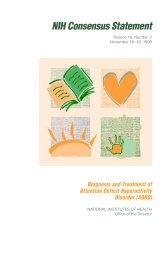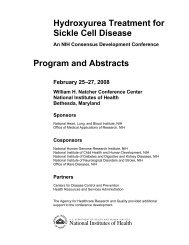Celiac Disease - NIH Consensus Development Program - National ...
Celiac Disease - NIH Consensus Development Program - National ...
Celiac Disease - NIH Consensus Development Program - National ...
You also want an ePaper? Increase the reach of your titles
YUMPU automatically turns print PDFs into web optimized ePapers that Google loves.
Association of <strong>Celiac</strong> <strong>Disease</strong> and Gastrointestinal (GI)Lymphomas and Other GI Cancers Carlo Catassi, M.D., M.P.H.The association between celiac disease (CD) and cancer is long established. The mostfrequent malignant complication of CD is a high-grade T-cell non-Hodgkin lymphoma (NHL) ofthe upper small intestine, usually defined as enteropathy-associated T-cell lymphoma (EATL). Ithas been suggested that patients with CD carry an increased risk of developing malignanciesother than NHL, especially small-intestinal adenocarcinoma and oesophageal and pharyngealsquamous carcinomas. (1)Recent epidemiological studies have shown that CD is one of the most common life-longdisorders in Western countries, affecting around 1 percent of the general population. Currently,most cases remain undiagnosed and are exposed to the risk of long-term complications. (2) For thisreason, the CD–cancer connection has gained a renewed interest, as this treatable disorder couldtheoretically represent a major risk factor for NHL and other malignancies.CD-Associated GI CancersEATL is an intestinal T-cell lymphoma that peaks in the sixth decade of life. With anannual incidence rate of 0.5–1 per million people in Western countries, this is a rare form ofcancer covering around 35 percent of all small bowel lymphomas. (3) By definition, this NHLsubtype arises in patients with either previously or concomitantly diagnosed CD. Occasionally,CD is recognized after the diagnosis of lymphoma has been made. The EATL immunophenotypeis consistent with a derivation from a clonal proliferation of intraepithelial lymphocytes (IEL). Insome cases EATL represents the end-stage evolution of refractory celiac sprue (RCS). RCS isdefined as symptomatic villous atrophy not responding to gluten-free diet (GFD) in a subjectinitially showing diagnostic features of CD. In approximately 80 percent of RCS cases, anabnormal clonal IEL population can be shown, frequently diffused along the intestinal tract,characterized by a low ratio of CD + 8/CD + 3and TCR gene rearrangement. This entity should beclassified as “cryptic EATL” as it is associated with a high risk of ulcerative jejunitis andlymphomatous transformation. (4)EATL commonly develops in the jejunum but may also be found in the ileum and lymphnodes, and less frequently in the stomach and the colon. It is often multifocal with ulcerativelesions. Extranodal presentations are not uncommon in the liver/spleen, thyroid, skin, nasalsinus, etc. Most patients present with malaise, anorexia, weight loss, and diarrhea, oftenassociated with abdominal pain. Physical signs include fever, lymphadenopathy, skin rash,hepatomegaly, and a palpable abdominal mass. Approximately 50 percent of patients requirelaparotomy for complications of haemorrhage, perforation, or obstruction. The suspicion ofEATL prompts an extensive diagnostic workup that may include upper and lower intestinalendoscopy, CT scan with enteroclysis, or small bowel follow through; either push or wirelessvideo-capsule enteroscopy. The final diagnosis is made on either endoscopic biopsies or fullthickness laparoscopic small bowel biopsies. The immunoistochemical study shows a large- ormedium-size T-cell proliferation mainly expressing a CD 3+, CD 8-, CD 103+phenotype. In most69







